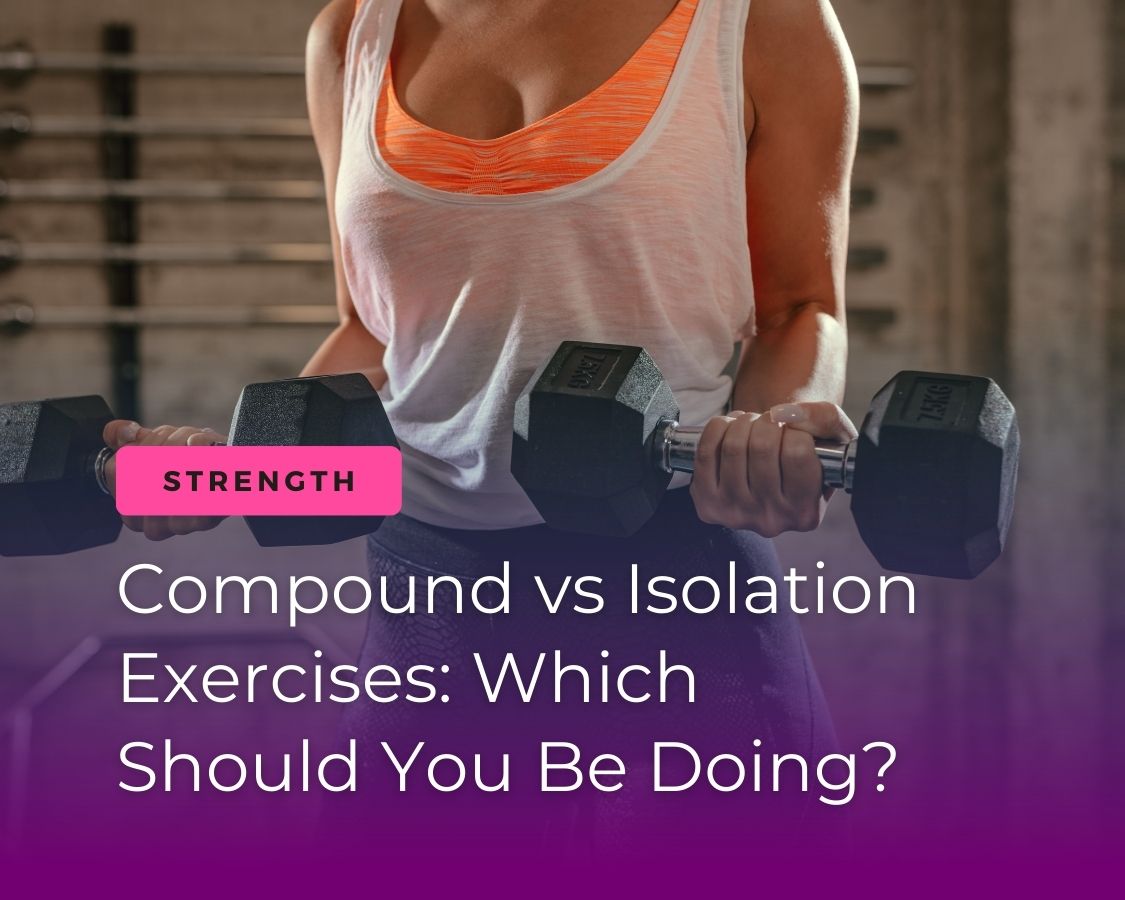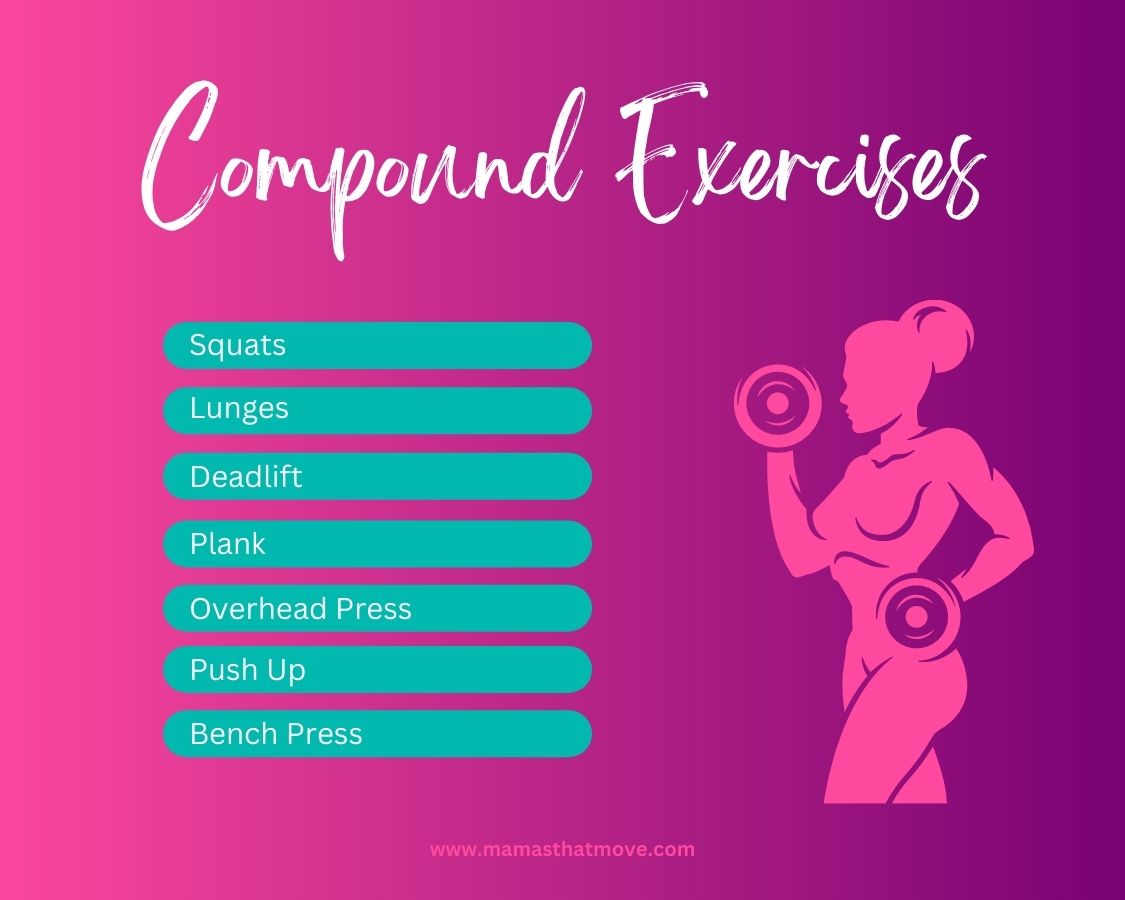- Home
- Strength Training for Women
- Compound vs Isolation Exercises
Compound vs Isolation Exercises: Which Should You Be Doing?
Compound vs Isolation exercises you know what they are and what you should be doing? I'm going to clear it up and the answer may not be what you think...
Beth's 1 Week Meal Plan

Have you come across the terms ‘compound exercises’ or ‘isolation exercises’? Or maybe both?
Do you know what
they are?
Which you should be
doing?
If they’ve left
you confused and worried that you’re going to have massive muscles,
then you’ve come to the right place.
Let’s take a
closer look at both of them and then you can decide which one is
right for you.
Ready?
Let’s do this...

Compound vs Isolation Exercises: What Are Isolation Exercises?
Isolation movements
are kind of what they sound like, they isolate specific muscle
groups. Usually, not always, a single muscle group.
I say not always
because it’s really hard for any exercise to use just one muscle
group. If you take the biceps curl as an example, it has to be the
most well recognised example of an isolation exercise. It’s all in
the name, but even this exercise actually uses more than just your
biceps.
Because just holding
a weight is going to recruit quite a few of your arm muscles. And
then if you’re standing up doing it, you’re going to recruit your
core muscles as stabilizer muscles.
It is really hard to
use just one group of muscles.
So, it might be
easier to think of isolation exercises, not for the muscles that they
work, but the muscles you’re trying to work with that exercise and
how many joints they’re using.
Isolation exercises
are single-joint movements.
Again, think of the
bicep curl...the only joint moving is your elbow joint. You might be
recruiting other muscles while you’re doing it, but you’re only
using one joint. And you’re doing it to work your biceps.
If you want to work
your core, there are so many other, really good exercises you could
do, bice[s curl is not really that efficient at working your core.
They are very good at working your biceps though.
Compound vs Isolation Exercises: What are Isolation Exercises Good For?

Isolation exercises
are most well-known in the body building world.
That’s because
they are amazing at increasing the size of the muscle that you’re
working. All of that attention on just one muscle. You bet they’re
going to grow. They’re going to get bigger. They’re going to get
stronger.
It’s the getting
stronger part that might be of interest to you.
If you’ve had an
injury, or you’ve got any muscle imbalances, isolation exercises
are great for sorting them out.
Or, if you’ve got
specific areas that you’re not particularly happy with.
Your arms for
example.
If you’ve got
wobbly arms, and you don’t want them to wobble, spending time
focusing on bicep curls and triceps extensions would do you the world
of good.
Keep in mind that you’re not going to be able to lift much weight with isolation exercises. Smaller muscle groups are generally weaker. So, keep to the lighter weights. Especially if you have injured muscles or you’re trying to correct imbalances.
Compound vs Isolation Exercises: What Are Some Examples of Isolation Exercises?

If isolation
exercises are single joint movements, anything that moves just one
joint is an isolation exercise.
Think curls, raises,
extensions, they’re all thought of as isolation exercises.
Bicep curls. Triceps
extensions. Calf raises. Leg extension. Hamstring curls. Lateral
raises.
All, great examples of isolation exercises.
Compound vs Isolation Exercises: What Are Compound Movements?
If isolation
exercises are single joint movements that focus on a specific area of
the body, compound movements are the exact opposite.
They are multi-joint
movements that tend to work multiple, large muscle groups in one
single movement.
Quite often, you could have a full-body workout with just one compound exercise.
Compound vs Isolation Exercises: What are Compound Movements Good For?

Single exercises
that have the potential to utilise the entire body? They are a great
way to get in a quick workout if you’ve not got a lot of time.
But, there’s more
to them than just a quick workout.
Compound movements
train your body in a very functional way.
If you think about
it, there’s very little that we do in our daily lives that uses
only one muscle group. Most of our daily tasks use lots of muscles.
Walking up the
stairs. Your calves, your quads, your hamstrings, your glutes, your
core. They are all being used in that simple movement.
Even just walking,
uses pretty much the same amount of muscle.
Add in any kind of
speed to either of those and you start to recruit your upper body as
well.
Lifting shopping
bags. Your forearms, your biceps, your triceps, your trapezius, your
deltoids, your lower back muscles, your glutes. All getting a work
out in just lifting your shopping off the floor.
Have to carry it to
the car, or into your house?
You start to use
your lower body as well.
It’s very, very
unusual for you to use just one muscle group in your daily life. So
the major benefit of compound movements is that they train your body
to be strong in ways that spill over to your daily life.
It’s called
functional strength.
And the result of
functional fitness? Your daily life becomes that bit easier.
Carrying your kids
from the park to the car, now becomes a breeze. Carrying the
shopping, a little bit easier. Running after your kids when they just
won’t listen, or maybe a game of tag, that becomes lots of fun.
And when things get
a bit easier, life becomes a bit less stressful. And I’m all about
finding the stress free in life.
You might be sold on
compound movements with just that, but there is one more thing
they’re good at...heavy weights.
Because you’re
using more, and larger muscle groups, with compound lifts you can
lift more. Heavier weights come into play. And lifting heavy weights
is lots of fun.
Don’t believe me?
Trust me on this
one.
When you start to
lift heavy you start to realise just what you’re capable of.
The heavy weight sat
in front of you. Doubts start to creep in. I’m not going to lift
this. What if I stumble and fall? What if I drop it?
You take a deep
breath, push those doubts to the back of your mind. Step up. Prepare
yourself. And lift.
You’ve done it.
YEAH!
It’s a great
feeling.
And that sense of
accomplishment, the sense that you can do anything, starts to trickle
down through the rest of your life.
And all of a sudden,
the kids tantrums don’t bother you quite as much. Pressure from
your boss, doesn’t take so much of a toll. Arguments with your
hubby don’t fester quite as long.
You’re stronger.
Physically. Mentally. Emotionally.
And yes, that is fun.
Compound vs Isolation Exercises: What Are Some Examples of Compound Exercises?

I bet, without too
much thought, you could give me an example of a compound exercise. In
fact I think you could name at least five.
Go on, give it a go.
Multi-joint
exercises that use more than one major muscle group. Have a go.
I’ve talked about
quite a few on other pages, so if you’ve read any of my other pages
you’ve got a head start.
The squat exercise
has to be one of the most well known. It uses the majority of your
lower body, calves, quads, glutes, hamstrings, knee joint, hip joint
and your ankles.
When you add in
weight, with say a barbell squat you’re also using your upper body.
Your deltoids, your trapezius, your biceps, your triceps, your lower
back and your core.
A complete whole
body workout in one movement.
Another example that
I’ve talked about, overhead presses. More of an upper body
exercise, but when you add in the weight, and having to get that
weight into position, it quickly becomes a full body exercise.
Some other examples
would be bench presses, dumbbell chest press, military press, lunge,
glute bridge, planks. Etc. Etc. Etc.
There are so many,
it would kind of be a waste of time me listing them all.
But, I may do that one day. Just out of interest.
Compound vs Isolation Exercises: Which One Should You Do?
This is not as
straight forward as you might think.
With all of the
benefits of compound exercises it might be tempting to stick to them.
And you’d certainly have good workouts and get fitter and stronger if you did that.
But, don’t write
off isolation movements.
They have their
place in any strength training program.
And depending on
what your goals are, your current physical ability, any pains,
imbalances or weaknesses you may have, focusing on individual muscles
might make up the bulk of your workout routine.
But, assuming you’re in good physical health, with no significant injuries, and your goal is to improve your overall strength, a typical training session would probably focus on compound movements at the beginning and a few accessory exercises at the end of your workout. Followed by a cardio finisher.
Compound vs Isolation Exercises: There’s Room For Both
The vast majority of
us actually need different types of exercises to have a well-rounded
and balanced workout plan.
And there is room
for all of them.
If you’re struggling for time, and can only fit a 15 minute workout into your day, focus most of your workouts on compound movements, with differing rep ranges. Have 1-2 days working on those accessory exercises and 1 day on mobility.
There really is room for all of it.
If you’ve enjoyed
this and want an eight week workout plan to get you started on your
fitness, fat loss, movement journey, then sign up to my newsletter.
You’ll not only get the plan, you’ll be the first to know when anything new is posted on Mamas that Move. Workouts, recipes, plans, tips and tricks. All of it. You’ll be the first in the queue.
Get Your Ultimate Free Eight Week HIIT Workout Plan
Get fitter, stronger and leaner in just eight weeks with my printable HIIT workout Plan. Just 30 minutes a day is all you need.
Want to know more before you sign up?
Check out Printable HIIT Workout Plan to learn all about the plan, what's involved and why you should get it.
Are Compound Exercises Better than Isolation Exercises?
Are Compound Exercises Better than Isolation Exercises?
This really depends on your goals and your fitness history. Because they both have their benefits and a place in a balanced workout plan.
Compound exercises are great for fat loss as they use more energy and keep your heart rate elevated more. Where as isolation exercises are great for working on weaknesses and imbalances you may have.
Should I do Compound or Isolation Exercises First?
Should I do Compound or Isolation Exercises First?
Compound movements should always go first in your workout.
Why?
Because they will be heavier, more taxing, so you’ll need to be fresh for those. If you tire out your small muscles with isolation exercises, you won’t be able to go as heavy with your compound lifts and you won’t reap their benefits.
Do You Really Need Isolation Exercises?
Do You Really Need Isolation Exercises?
Yes.
Isolation exercises
are just as important as the compound movements.
You’re only as
strong as your weakest link, so strengthening those weaknesses is an
important part of any good workout plan.
It’s also not a
good idea to start lifting heavy if you have imbalances in your body.
You will only make them worse and end up being injured.
That’s why I often spend a few weeks with my clients concentrating on isolation exercises and getting their bodies balanced and ready to lift those heavy weights.





